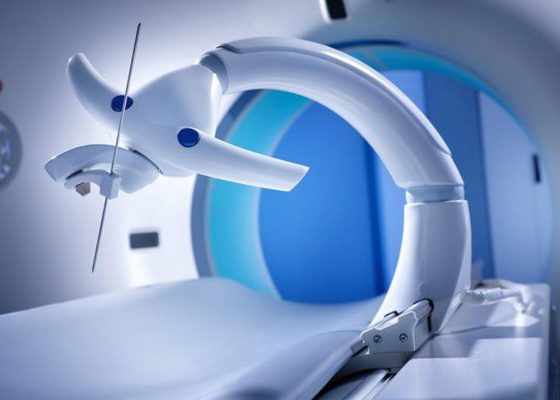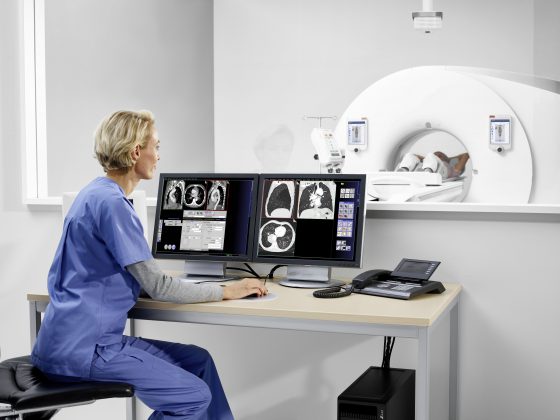Having a potential impact of saving 60,000-80,000 people with lung cancer per year within Europe
The scientific article ‘’Reduced Lung Cancer Mortality with Volume CT Screening in the NELSON trial” was recently published in the leading New England Journal of Medicine (NEJM) and has already been viewed more than 50,000 times on the NEJM website, making it a top 1% best viewed article. The scope and outcome of this trial will be explained below.
NELSON vs lung cancer screening
NELSON (“NEderlands-Leuvens Longkanker Screening ONderzoek”), is the Dutch-Belgian lung cancer early detection trial headed by prof. H. de Koning and prof. M. Oudkerk. It is a population-based randomized-controlled trial initiated in the early 2000’s. It’s primary goal was to determine whether volume computed CT screening reduces lung cancer mortality in male former and current smokers.
15.789 male and women, aged 50-74, were randomly assigned to CT-screening at the beginning of the trial (baseline), with intervals of 1, 2, and 2,5 years, or to a control group with no CT-screening.
A minimum follow-up of 10 years until December 31, 2015 was completed for all participants.
Download the NELSON longkanker screening infographic (NL)
Download a PDF of the NEJM publication abstract here
Volume computed tomography (CT) early detection is the key to success!
The NELSON trial has shown that by using low-dose CT scanners, lung cancer mortality can be reduced within the population of former and current smokers. Low-dose CT scanners generate high-resolution imaging, showing relevant lung nodules if present.
The NELSON trial uses a “volume-based” principle, where the increase in volume of the lung nodule is measured over time. This is proven to be a much better predictive value for developing lung cancer, then looking at the increase in diameter used in other lung cancer screening trials, leading to a false-positive rate of only 1,2% “A lung nodule has an infinite number of diameters, but only one volume, as prof. Oudkerk (PI of the NELSON and co-founder of iDNA) states: “Our volume-based CT measurement is the prime reason why our false-positives rates are so much lower than the NLST”. Therefore, volume-based CT early detection truly unlocks the full potential for implementation of lung cancer early detection programmes worldwide.
How is a low-dose CT system used within lung cancer early detection?
It’s faster and can reveal lung abnormalities much better than conventional X-rays. Compared to a conventional CT, the low-dose CT scanner for lung cancer uses approximately 5 times less radiation (1-4 vs 5-20 mSv). Thus, it’s also much safer. In addition, ultra-low-dose CT scanners, as used by iDNA, are also currently entering the market with even lower radiation doses (
NELSON potentially preventing 60,000-80,000 lung cancer deaths within Europe
Looking at the results of the NELSON trial, the men and women assigned to the low-dose CT screening group showed a considerable reduction in the lung cancer mortality compared to the control group. The potential impact of having a national screening programme in place in Europe would be to prevent 60,000-80,000 lung cancer deaths annually within Europe [1]. The compelling reason to act now!
A link to the publication can be found here
What’s next on the agenda?
Implementation of early detection of lung cancer within Europe is the next step. However, implementation is likely to be limited, slow and of uncontrolled quality throughout Europe.
Therefore, in order to address the requirements for a succesful implementation in Europe, iDNA and ErasmusMC initiated the 4-In-The-Lung-Run (4ITLR) under quality controlled and monitoring conditions.
4ITLR’s purpose is to set THE golden standard for implementing (cost)efficient national early detection programmes within Europe to address lung cancer. 4ITLR starts in 2020 and includes 5+ sites throughout Europe. iDNA and Erasmus MC, the Netherlands, will supervise the 4ITLR project, together with other renowned (academic) partners. 4ITLR has received initial funding from the EU (H2020 grant).
Want to know more? Please visit www.i-DNA.org/4ITLR
Act now to set up national EARLY DETECTION programmes!
Setting the stage to successfully implement national programmes, it is vital to reach out to the required national health councils, governments and policy makers.
iDNA is looking for partners to join in their mission to reduce lung cancer mortality.
Please contact iDNA for questions! Visit www.i-DNA.org/solutions
For more information please contact +31 (0)50 211 03 48
- Ferlay J, Colombet M, Soerjomataram I, et al. Cancer incidence and mortality patterns in Europe: Estimates for 40 countries and 25 major cancers in 2018. Eur J Cancer 2018; 103: 356-87



